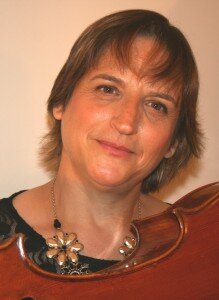Interview with Michal Schmidt, pianist and cellist extraordinaire
Michal Schmidt,
cellist and pianist
A few years ago, I was astonished by an amazing feat of musicianship. At a piano trio recital program for Tri-County Concerts, I saw and heard the cellist, Michal Schmidt, lay down her cello and move to the piano to perform Ravel’s Violin Sonata with violinist Min-Young Kim, so that Matt Bengston, who had just performed Ravel’s solo piano masterpiece Gaspard de la nuit, could take a much-deserved break.
Okay, I’ll admit that I’m picky when it comes to piano playing. It’s not a small thing and also not an exaggeration when I say that Michal’s tone, phrasing, fluency at the keyboard, and sensitivity to the violinist, were exquisite examples of finesse, artistry, and beauty. So it was an honor and a pleasure when she asked me to collaborate with her on a number of interesting recitals this season — two of which are coming up next month.
Rarely is an instrumentalist so exacting and vocal about the piano part — my part. In rehearsal with Michal, I submerge my ego and keep an open mind, knowing that she can play the piano part perfectly well herself. It’s been ear-opening and a lot of fun.
Today I’d like to interview this superb cellist, pianist, wife, mother, and colleague, and share with you her insights into her unique career and life.
DLH: Tell me a little about your growing-up years, and if anybody in your family was a professional musician.
MS: I grew up in a little town in the northern Galilee in Israel. As a teen we moved to Haifa, the port city more to the south. I have 5 siblings. Everyone played an instrument at some point in their lives. My mom played piano very well (she still does at age 84) but in her professional life she is a world-renowned sociologist, and was a professor at the Haifa University for over 30 years. My dad was a teacher at a vocational school. He played the cello and the flute as an amateur for many years.
DLH: How old were you when you began music lessons, and which instrument came first?
MS: I started piano lessons with my mom when I was about 5 years old. Piano was my passion from age three or so. My mom says I would cry and ask for my “la” and my “mi” and my “do.”
Cello came later, when I was about 10.
DLH: You came to study at the Curtis Institute as a young woman. Were you admitted to study both instruments? Did any one instrument begin to take precedence?
I came to Curtis in September of 1978, after a year at the Royal Academy of Music in London. I did get accepted on both instruments, which was rare. Later I found that maybe it was an unspoken “no-no” at the school. They were not too tolerant of the fact that I was playing and practicing both and doing the course load of the two departments. At the time I felt my cello playing needed a push, so I decided to study piano privately outside the school and I got plenty of push in cello at Curtis. Now both instruments are pretty much on equal footing, and I practice them both, as much as I possibly can.
DLH: You subsequently earned your doctorate at Temple University, in which discipline?
MS: My doctorate at Temple U was in cello performance. I studied there with Jeffrey Solow.
DLH: What appeals to you about playing each instrument, and what does each bring out in you as an artist? You are clearly a “people-person” and both instruments allow you to collaborate with other musicians. Do you feel the cello brings out the soloistic side of you?
MS: I love the richness of repertoire for the piano, the unlimited possibilities of the instrument and the chance to accompany, which is my favorite thing to do as a pianist.
The cello, at times, has been more of a soloistic instrument for me, but also with it, I am thrilled to collaborate with colleagues.
DLH: You’ve raised three healthy, well-adjusted kids, and we all know that juggling work-life balance can be difficult with a family and a demanding music career. Does any one incident as a working musician and mother stand out?
MS: The mix of motherhood and artistic work has been just that, a mix for many years. I did what I could, and remember being exhausted all the time! One incident that comes to mind- I organized a big concert in memory of a loved teacher. I was the organizer, producer, accompanist for seven singers and cello soloist for one piece as well. I got home late after the concert, and went right to my baby, Abby, who was then less than a year old (she is now 19). The abrupt switch from “stage glamour” to changing diapers struck me very strongly – to this day I remember the precise date of that concert in 1995!
DLH: Now that you’ve recently become an empty-nester, do you have new goals for your life or career?
MS: Now with less worry about young kids, I would love to do more of what I have been doing, knowing that I CAN do more, because no one pulls at my arm to go make dinner NOW.
DLH: Do you have any advice for young musicians who are talented in two instruments and who would like to make music their profession?
MS: The advice is to keep practicing, and if you love both, do both. The main point is, that in our time, a music career may be such a difficult path, so diversifying may be important. Think of not only the one passion — maybe you have another passion that can help you with real life’s demands.
With that in mind — this week I learned in French the idiom “violon d’Ingres” — “the violin of Ingres” (the 18th century painter). This is an idiom that describes one’s passion, or a very loved hobby. It sounded so cool, I went searching for the source of this idiom.
So the story goes that when people came to Ingres’ studio to see his paintings, he preferred to play the violin for them, as he was a decent player. So his music passion went beyond and along with his passion for painting, for which he was famous.


